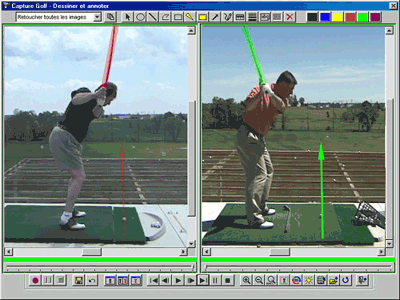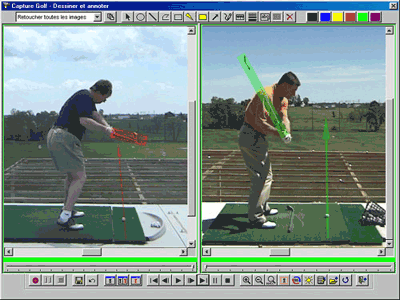Downswing

It goes without saying that the descent will probably be poor if the rise is bad. This will produce a swing in the wrong plane (plane swing). In the following example, you can see using a series of comparative pictures the swing to be corrected with the red marks on the left side, and the right swing with the green notes on the right side. We chose two descents and stopped the images at about the same critical points. We based ourselves on the position of the hands on the way down to be able to compare.
On the first picture, position the hands in the same place (the height of the neck). We can already note two mistakes on the left. The club begins already to be outside of the imaginary target line. The upper body leans down and causes a transfer of weight forward. On the right side, the club remains well behind the line, the head is raised.

On the second picture, again to the left, the club is incorrectly positioned in relation to the target line. The club being almost on top of the line, while on the right the club is still behind the line. The 90 degree angle between the arm and the club is once again well respected

Again in this picture, the hands are at the same level (the hips). Note the huge difference between the two pictures. The left one shows that the club is now on the other side of the line of the target. This means that it will be create a swing from the outside to the inside, which will probably cause a "slice". The shoulders have rotated forward and the body has already passed the ball. On the right, the club is still behind the line of the target. Shoulders begin to rotate.

The following picture was taken a split second before impact. On the left, the club head is clearly on the other side of the line. The club has then only one place to head to, that is to say, inward to hit the ball. This will probably cause an unintended effect on the ball. Also, arms and club do not meet the desired angle. The club is already the extension of the arm, this movement called "Casting" is often observed among amateurs who are anxious to hit the ball. This causes most of the time a loss of power. On the right side, the angle of the club with the arm is still respected. This will allow the wrists to "whip" the ball. Also notice how the club forms a line parallel with the line of the target. However, the club is still behind the target line.
